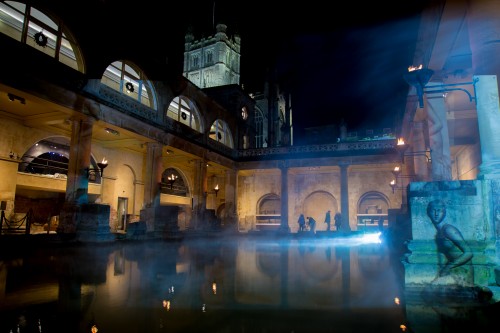By James Dacey
In what could be described as the West Country’s answer to Diwali, the city of Bath in the UK has just hosted an eight-day festival of light, featuring colourful public artworks based on lighting technologies. “Illuminate 2015” was one of the first events on the calendar in this International Year of Light, the UNESCO-supported celebration of light science and its applications. I popped along to the event last Thursday to find out what it was all about and I’ve put together this short film, which includes the event’s creative director Anthony Head explaining what the festival is all about.
“It’s a subtle introduction to experimenting with science,” says Head, referring to the fact that many of the exhibits are interactive and involve some playful experimentation. One such exhibit, called “Light Painting”, invited the general public to create images that were then projected onto some of the local buildings. Another exhibit, called “Sonic: Sullis”, enabled people to create sounds and light projections by simply disturbing water contained in a box.
Many of the exhibits interacted playfully with the history of Bath, which became a spa town when the Romans discovered the area’s natural hot springs. The city became very popular during the Georgian era and today much of the architecture reflects the style of that period. One of the local landmarks, Pulteney Bridge, was brought to life with projections of Georgians in period costume that had been drawn by local schoolchildren. Meanwhile, the Roman baths were made to look eerily beautiful as colourful holographic figures appeared to emerge from the steaming waters.

‘Only the Statues Remain’ bathed Bath’s Roman baths in colour. (Courtesy: Chris Wakefield/Crescent Photography)
The entrance wall to the Roman baths was the site of one of the more technically challenging exhibits of the festival. In “Elastic City Spacey”, stereographic 3D images were projected onto the building in a work created by Canadian video artist Leila Sujir, who says it is the first work of its kind in the world. Again, the imagery reflected the city’s past, including Roman coins and peacocks – the animals strongly associated with a nearby country house called Corsham Court.
“For me, it’s really brilliant to have this at the darkest time of the year. We’ve just passed the winter solstice and it’s really dark and gloomy,” says Sujir. “So I’ve been really impressed with the turnout and the engagement of the city.”
The International Year of Light kicks off officially next week with the opening ceremony in France. I will be attending the event along with Physics World editor Matin Durrani, so watch this space for reports from that event.
Light is perhapse the most natural artistic material that can be handled by different techniques and tricks into different dynamic forms and figures.
Trackback: Physics Viewpoint | Lighting up a mid-winter Bath